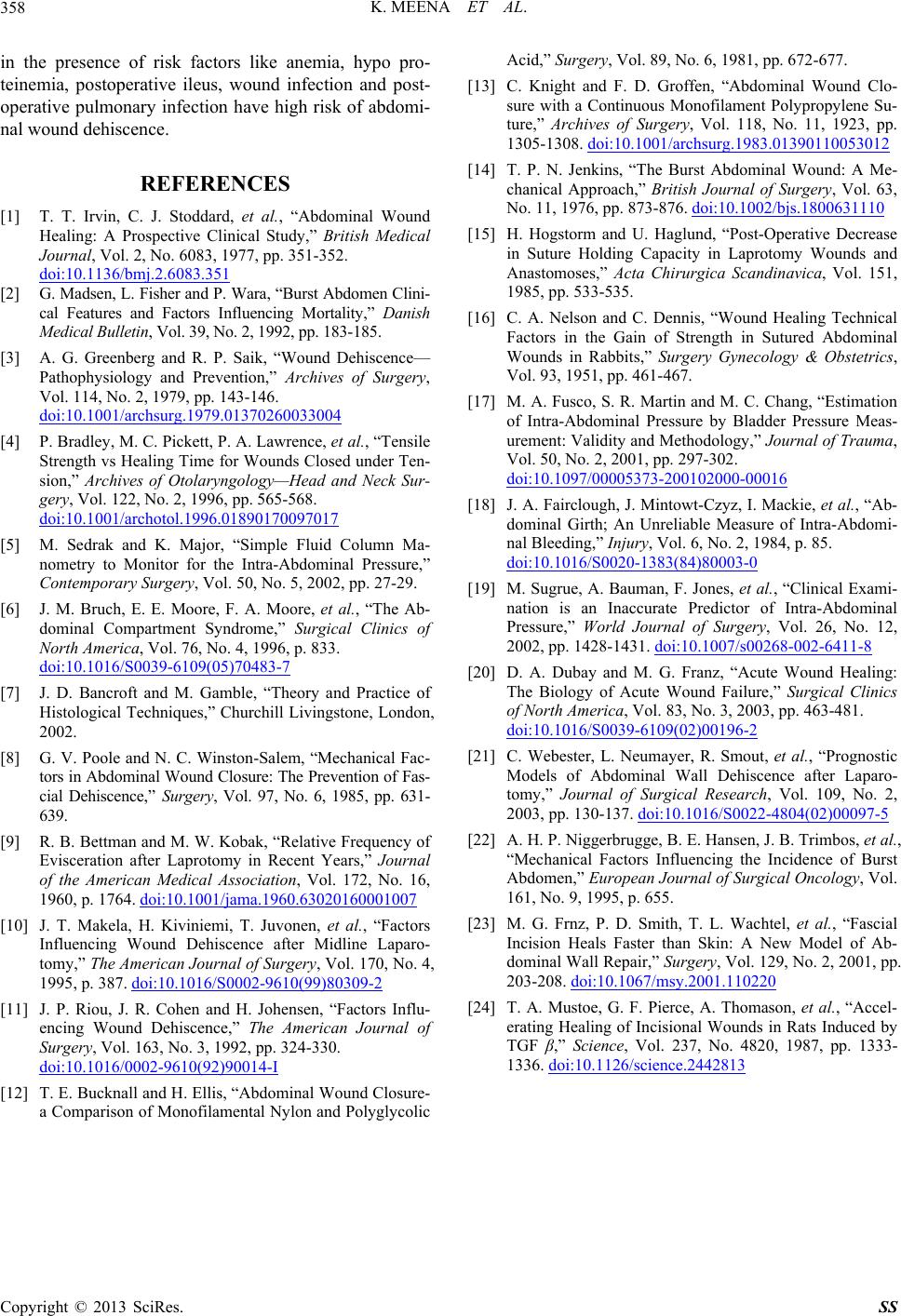
K. MEENA ET AL.
Copyright © 2013 SciRes. SS
358
in the presence of risk factors like anemia, hypo pro-
teinemia, postoperative ileus, wound infection and post-
operative pulmonary infection have high risk of abdomi-
nal wound dehiscence.
REFERENCES
[1] T. T. Irvin, C. J. Stoddard, et al., “Abdominal Wound
Healing: A Prospective Clinical Study,” British Medical
Journal, Vol. 2, No. 6083, 1977, pp. 351-352.
doi:10.1136/bmj.2.6083.351
[2] G. Madsen, L. Fisher and P. Wara, “Burst Abdomen Clini-
cal Features and Factors Influencing Mortality,” Danish
Medical Bulletin, Vol. 39, No. 2, 1992, pp. 183-185.
[3] A. G. Greenberg and R. P. Saik, “Wound Dehiscence—
Pathophysiology and Prevention,” Archives of Surgery,
Vol. 114, No. 2, 1979, pp. 143-146.
doi:10.1001/archsurg.1979.01370260033004
[4] P. Bradley, M. C. Pickett, P. A. Lawrence, et al., “Tensile
Strength vs Healing Time for Wounds Closed under Ten-
sion,” Archives of Otolaryngology—Head and Neck Sur-
gery, Vol. 122, No. 2, 1996, pp. 565-568.
doi:10.1001/archotol.1996.01890170097017
[5] M. Sedrak and K. Major, “Simple Fluid Column Ma-
nometry to Monitor for the Intra-Abdominal Pressure,”
Contemporary Surgery, Vol. 50, No. 5, 2002, pp. 27-29.
[6] J. M. Bruch, E. E. Moore, F. A. Moore, et al., “The Ab-
dominal Compartment Syndrome,” Surgical Clinics of
North America, Vol. 76, No. 4, 1996, p. 833.
doi:10.1016/S0039-6109(05)70483-7
[7] J. D. Bancroft and M. Gamble, “Theory and Practice of
Histological Techniques,” Churchill Livingstone, London,
2002.
[8] G. V. Poole and N. C. Winston-Salem, “Mechanical Fac-
tors in Abdomina l Wound Closure: The Preventio n of Fas-
cial Dehiscence,” Surgery, Vol. 97, No. 6, 1985, pp. 631-
639.
[9] R. B. Bettman and M. W. Kobak, “Relative Frequency of
Evisceration after Laprotomy in Recent Years,” Journal
of the American Medical Association, Vol. 172, No. 16,
1960, p. 1764. doi:10.1001/jama.1960.63020160001007
[10] J. T. Makela, H. Kiviniemi, T. Juvonen, et al., “Factors
Influencing Wound Dehiscence after Midline Laparo-
tomy,” The American Journal of Surgery, Vol. 170, No. 4,
1995, p. 387. doi:10.1016/S0002-9610(99)80309-2
[11] J. P. Riou, J. R. Cohen and H. Johensen, “Factors Influ-
encing Wound Dehiscence,” The American Journal of
Surgery, Vol. 163, No. 3, 1992, pp. 324-330.
doi:10.1016/0002-9610(92)90014-I
[12] T. E. Bucknall and H. Ellis, “Abdominal Wound Closure-
a Comparison of Monofilamental Nylon and Polyglycolic
Acid,” Surgery, Vol. 89, No. 6, 1981, pp. 672-677.
[13] C. Knight and F. D. Groffen, “Abdominal Wound Clo-
sure with a Continuous Monofilament Polypropylene Su-
ture,” Archives of Surgery, Vol. 118, No. 11, 1923, pp.
1305-1308. doi:10.1001/archsurg.1983.01390110053012
[14] T. P. N. Jenkins, “The Burst Abdominal Wound: A Me-
chanical Approach,” British Journal of Surgery, Vol. 63,
No. 11, 1976, pp. 873-876. doi:10.1002/bjs.1800631110
[15] H. Hogstorm and U. Haglund, “Post-Operative Decrease
in Suture Holding Capacity in Laprotomy Wounds and
Anastomoses,” Acta Chirurgica Scandinavica, Vol. 151,
1985, pp. 533-535.
[16] C. A. Nelson and C. Dennis, “Wound Healing Technical
Factors in the Gain of Strength in Sutured Abdominal
Wounds in Rabbits,” Surgery Gynecology & Obstetrics,
Vol. 93, 1951, pp. 461-467.
[17] M. A. Fusco, S. R. Martin and M. C. Cha ng, “Estimation
of Intra-Abdominal Pressure by Bladder Pressure Meas-
urement: Validity and Methodology,” Journal of Trauma,
Vol. 50, No. 2, 2001, pp. 297-302.
doi:10.1097/00005373-200102000-00016
[18] J. A. Fairclough, J. Mintowt-Czyz, I. Mackie, et al., “Ab-
dominal Girth; An Unreliable Measure of Intra-Abdomi-
nal Bleeding,” Injury, Vol. 6, No. 2, 1984, p. 85.
doi:10.1016/S0020-1383(84)80003-0
[19] M. Sugrue, A. Bauman, F. Jones, et al., “Clinical Exami-
nation is an Inaccurate Predictor of Intra-Abdominal
Pressure,” World Journal of Surgery, Vol. 26, No. 12,
2002, pp. 1428-1431. doi:10.1007/s00268-002-6411-8
[20] D. A. Dubay and M. G. Franz, “Acute Wound Healing:
The Biology of Acute Wound Failure,” Surgical Clinics
of North America, Vol. 83, No. 3, 2003, pp. 463-481.
doi:10.1016/S0039-6109(02)00196-2
[21] C. Webester, L. Neumayer, R. Smout, et al., “Prognostic
Models of Abdominal Wall Dehiscence after Laparo-
tomy,” Journal of Surgical Research, Vol. 109, No. 2,
2003, pp. 130-137. doi:10.1016/S0022-4804(02)00097-5
[22] A. H. P. Niggerbrugge, B. E. Hansen, J. B. Trimbos, et al.,
“Mechanical Factors Influencing the Incidence of Burst
Abdomen,” European Journal of Surgical Oncology, Vol.
161, No. 9, 1995, p. 655.
[23] M. G. Frnz, P. D. Smith, T. L. Wachtel, et al., “Fascial
Incision Heals Faster than Skin: A New Model of Ab-
dominal Wall Repair,” Surgery, Vol. 129, No. 2, 2001, pp.
203-208. doi:10.1067/msy.2001.110220
[24] T. A. Mustoe, G. F. Pierce, A. Thomason, et al., “Accel-
erating Healing of Incisional Wounds in Rats Induced by
TGF β,” Science, Vol. 237, No. 4820, 1987, pp. 1333-
1336. doi:10.1126/science.2442813